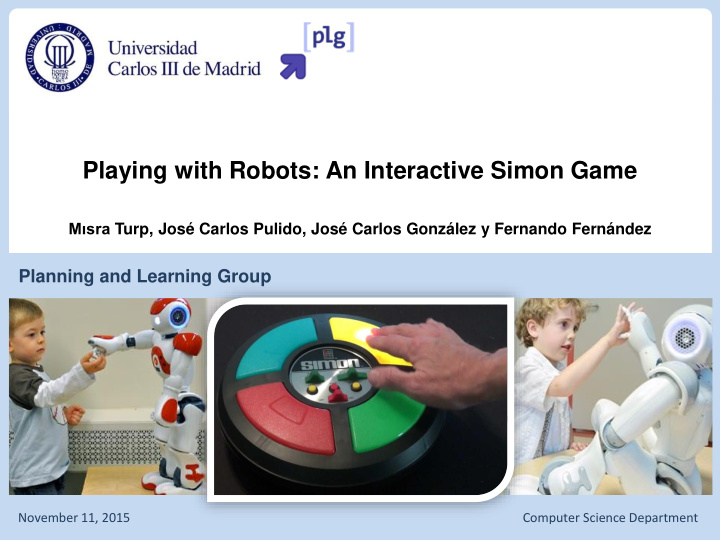



Playing with Robots: An Interactive Simon Game Mısra Turp, José Carlos Pulido, José Carlos González y Fernando Fernández Institute for Process Control and Robotics (IPR), Automation and Robotics Planning and Learning Group November 11, 2015 KIT – University of the State of Baden-Wuerttemberg and Computer Science Department www.kit.edu National Research Center of the Helmholtz Association
Overview 1. Introduction 2. Simon in NAOTherapist 3. Evaluations 4. Conclusions Playing with Robots: An Interactive Simon Game 2
Playing with Robots: An Interactive Simon Game 3
The Simon Game • http://www.freesimon.org • Electronic memory and exercise game • Arms postures, instead of colors • With a NAO robot Playing with Robots: An Interactive Simon Game 4
Playing Simon with NAO • Poses use one arm at a time • Enough time/tries to achieve the pose • Encouraging and supportive speech • Based on NAOTherapist architecture Playing with Robots: An Interactive Simon Game 5
Playing with Robots: An Interactive Simon Game 6
The NAOTherapist Architecture Therapy configuration Therapy Designer High-level planning Planned sessions Anthropometric data Decision Support Medium-level planning Kinect Sensor Actions Low-level Instructions Robot Controller Low-level planning NAO robot Playing with Robots: An Interactive Simon Game 7
Game Flow Playing with Robots: An Interactive Simon Game 8
Medium-level Planning Domain • PDDL language – Problem: Initial and goal state of the world – Domain: Actions with preconditions and effects in the state • Iterative loops of the domain – A sequence consists of consecutive poses – A game consists of consecutive sequences • Pose shuffling mechanism – Pseudorandom seed Playing with Robots: An Interactive Simon Game 9
Medium-level Actions Playing with Robots: An Interactive Simon Game 10
Medium-level Actions • https://youtu.be/Wd7TPXWOnog Playing with Robots: An Interactive Simon Game 11
Playing with Robots: An Interactive Simon Game 12
Test Sessions Statistics of the test sessions • Despite the raise in the know-how in the second game, the difference of durations are not wide, as a consequence of increased difficulty. • Only in some cases there were high pose reminders. Thus the high standard deviation. • After 70% of the pose reminders, participants managed to perform the pose. • Half the participants never skipped a pose. Playing with Robots: An Interactive Simon Game 13
Questionnaires Questionnaires outcomes Playing with Robots: An Interactive Simon Game 14
Questionnaires Feelings average rating (from 0 to 5) Playing with Robots: An Interactive Simon Game 15
Questionnaires • New evaluations with 56 schoolchildren of 5-6 years old Playing with Robots: An Interactive Simon Game 16
Long-term evaluations! @NAO_Therapist Playing with Robots: An Interactive Simon Game 17 NAOTherapist
Conclusions • Outlook – The anxiety factor should be addressed with a solution. – To prevent faulty perception of self pose , necessary actions should be developed. • Improvements and alterations can take place on the current version such as mirror correction or reversed Simon . • Even though the main target audience was fairly limited to children with physical disorders, we have seen that the project can go beyond the initial goal. Playing with Robots: An Interactive Simon Game 18
Playing with Robots: An Interactive Simon Game Mısra Turp, José Carlos Pulido, José Carlos González y Fernando Fernández Institute for Process Control and Robotics (IPR), Automation and Robotics Planning and Learning Group November 11, 2015 KIT – University of the State of Baden-Wuerttemberg and Computer Science Department www.kit.edu National Research Center of the Helmholtz Association
Recommend
More recommend